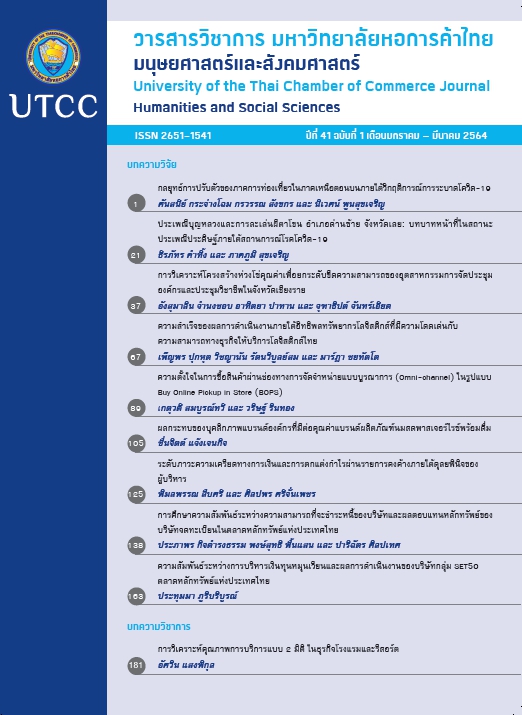Success of the Performance under the Influence of Salient Logistics Resource and Thailand Logistics Service Business Capabilities
Main Article Content
Abstract
The logistics service providers in Thailand are now a small business group. Their skills and knowledge are limited to some specific services. It is also difficult for them to access to low-cost financial sources, which results in the lack of business expansion opportunities and low competitiveness due to the lack of continued business cooperation. As a result, entrepreneurs have low bargaining power and have to face severe price frictions of large companies or
multinationals. Therefore, this article aims to model the structural equations for the success of performance in order to determine the path of development and increase the efficiency of
business management. This was achieved by reviewing literature related to resource-based theory and employing a mixed research methodology starting from quantitative research and then qualitative methods. The data were collected by questionnaires and semi-structured interviews
that passed the research tool test criteria. Questionnaires of ideas from business enterprises with net profits in 2017 were used. The results showed that if logistics service providers wanted to see their business growth, they needed to continuously improve their quality and management
system, especially in the area of ability to provide logistics services, which was a holistic work management. This would result in a link between working processes in the organization, which agreed to the work system of external stakeholders and had the same standard. Moreover, logistics service providers should also get supports and readiness of outstanding logistics resources that
aligned with their operations in order to create added value for their organization and contribute to the potential of working effectively of their personnel.
Article Details

This work is licensed under a Creative Commons Attribution-NonCommercial-NoDerivatives 4.0 International License.
ลิขสิทธิ์ของบทความ
ผลงานที่ได้รับการตีพิมพ์ถือเป็นลิขสิทธิ์ของมหาวิทยาลัยหอการค้าไทย ห้ามมิให้นำเนื้อหา ทัศนะ หรือข้อคิดเห็นใด ๆ ของผลงานไปทำซ้ำ ดัดแปลง หรือเผยแพร่ ไม่ว่าทั้งหมดหรือบางส่วนโดยไม่ได้รับอนุญาตเป็นลายลักษณ์อักษรจากมหาวิทยาลัยหอการค้าไทยก่อน
References
กรมเจรจาการค้าระหว่างประเทศ. (2556). รายงานฉบับสมบูรณ์โครงการศึกษาวิจัยโอกาส ผลกระทบ และมาตรการรองรับสำหรับธุรกิจให้บริการโลจิสติกส์ไทยจากการจัดทำเขตการค้าเสรี พฤษภาคม 2556. สืบค้นเมื่อ 6 พฤศจิกายน 2560, จาก http://www.thaifta.com/thaifta/Home/รายงานการศึกษา/tabid/55/ctl/Details/mid/435/ItemID/7923/Default.aspx
กรมพัฒนาธุรกิจการค้า. (2559). เกณฑ์มาตรฐานคุณภาพการบริหารจัดการธุรกิจให้บริการโลจิสติกส์และเกณฑ์มาตรฐานคุณภาพการบริหารจัดการธุรกิจขนส่งสินค้าทางถนน ปี พ.ศ. 2558. สืบค้นเมื่อ 26 เมษายน 2561, จาก http://www.dbd.go.th/more_news.php?cid=869
กรมพัฒนาธุรกิจการค้า. (2561). คู่มือการพัฒนาระบบบริหารคุณภาพตามมาตรฐานสากล ISO 9001 สำหรับธุรกิจให้บริการโลจิสติกส์. สืบค้นเมื่อ 26 เมษายน 2561, จาก https://www.dbd.go.th/download/article/article_20190704132751.pdf
กรมพัฒนาธุรกิจการค้า. (2563). แหล่งค้นหาข้อมูลนิติบุคคลและประเภทธุรกิจในประเทศไทย. สืบค้น
เมื่อ 26 เมษายน 2561, จาก https://datawarehouse.dbd.go.th/index
ธนุตร์ เอี่ยมอร่าม. (2556). ทฤษฎีพื้นฐานของทรัพยากร: แหล่งกำเนิดความได้เปรียบในการแข่งขันอย่างยั่งยืนของผู้ประกอบการ SMEs. วารสารวิชาการ มหาวิทยาลัยหอการค้าไทย, 33(ฉบับพิเศษ), 302-316.
สำนักงานคณะกรรมการพัฒนาการเศรษฐกิจและสังคมแห่งชาติ. (2560). รายงานโลจิสติกส์ของประเทศไทยประจำปี 2559. สืบค้นเมื่อ 20 ตุลาคม 2560, จาก
https://www.nesdc.go.th/ewt_dl_link.php?nid=8119
สำนักงานคณะกรรมการพัฒนาการเศรษฐกิจและสังคมแห่งชาติ. (2561). GDP ไตรมาสที่สี่ ทั้งปี 2560 และแนวโน้มปี 2561. สืบค้นเมื่อ 26 เมษายน 2561, จาก http://www.nesdb.go.th/ewt_dl_link.php?nid=5165
สุภมาส อังศุโชติ, สมถวิล วิจิตรวรรณา, และรัชนีกูล ภิญโญภานุวัฒน์. (2554). สถิติวิเคราะห์สำหรับการวิจัยทางสังคมศาสตร์และพฤติกรรมศาสตร์: เทคนิคการใช้โปรแกรม LISREL (พิมพ์ครั้งที่ 3). กรุงเทพฯ: เจริญดีมั่นคงการพิมพ์.
Barney, J. B., & Clark, D. N. (2007). Resource‐based theory: Creating and sustaining competitive advantage. Oxford, England: Oxford University Press.
Darkow, I. L., Weidmann, M., & Lorentz, H. (2015). Adaptation of foreign logistics service providers' resources and capabilities to a new institutional environment. Retrieved July 9, 2017, from https://ideas.repec.org/a/bla/jscmgt/v51y2015i1p27-51.html
Hair, J. F., Black, W. C., Babin, B. J., & Anderson, R. E. (2010). Multivariate data analysis (7thed.). Upper Saddle River, NJ: Pearson Prentice Hall.
Karia, N., Wong, C. Y., Asaari, M. H. A. H., & Lai, K. (2015). The effects of resource bundling on third-party logistics providers’ performance. International Journal of Engineering Business Management, 7(9), 1-14.
Kuo, S. Y., Lin, P. C., & Lu, C. S. (2017). The effects of dynamic capabilities, service capabilities, competitive advantage, and organizational performance in container shipping. Transportation Research Part A: Policy and Practice, 95, 356–371.
Lavie, D. (2006). The competitive advantage of interconnected firms: An extension of the resource-based view. The Academy of Management Review, 31(3), 638–658.
Mandal, S., & Korasiga, V. R. (2016). An integrated-empirical logistics perspective on supply chain innovation and performance. Business: Theory and Practice, 17(1), 32–45.
Ralston, P. M., Grawe, S. J., & Daugherty, P. T. (2013). Logistics salience impact on logistics capabilities and performance. The International Journal of Logistics Management, 24(2), 136-152.
Rodrigo, M. R., Virginia, F. P., & Encarnación, G. S. (2016). Encouraging organization performance through the influence on technological distinctive competence on component of corporate entrepreneurship. International Entrepreneurship and Management Journal, 13(2), 397-426.
Samira, S., Mohammadreza, D. E., & Navid, N. (2013). Explain the theory of competitive advantage and comparison with industries based on advanced technology. International Journal of Economy, Management and Social Sciences, 2(10), 841-84.
Selviaridis, K., & Spring, M. (2007). Third party logistics: A literature review and research agenda. The International Journal of Logistics Management, 18(1), 125-150.
Wang, H. L. (2014). Theories for competitive advantage. Retrieved July 9, 2017, from https://ro.uow.edu.au/buspapers/408/
Wang, M., Jie, F., & Abareshi, A. (2015). Evaluating logistics capability for mitigation of supply chain uncertainty and risk in the Australian courier firms. Asia Pacific Journal of Marketing and Logistics, 27(3), 486-498.
Wheelen, T. L., & Hunger, J. D. (2010). Strategy management and business policy: Achieving sustainability. Upper Saddle River, NJ: Pearson Prentice Hall.
Yorulmaz, M., & Birgün, S. (2017). Maritime transport logistics service capabilities impact on customer service and financial performance: An application in the Turkish maritime sector. Journal of Business Research Turk, 3(9), 468-486.
Zacharia, Z. G., & Mentzer, J. T. (2004). Logistics salience in a changing environment. Journal of Business Logistics, 25(1), 187-210.
Zacharia, Z. G., & Mentzer, J. T. (2007). The role of logistics in new product development. Journal of Business Logistics, 28(1), 83-110.


